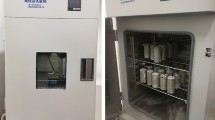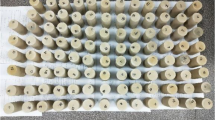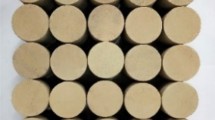Abstract
The freeze–thaw (FT) cycle will lead to rock damage and cause hidden danger to the safety of rock engineering. In order to explore the FT damage characteristics of rocks in cold regions, 0, 20, 30, 40 and 50 FT cycle tests and uniaxial compression tests were carried out on intact and single-fracture cyan specimens with crack inclination angle β of 0°, 45° and 90°, respectively, to study the FT damage problems of rocks from the aspects of physical, mechanical and energy characteristics. The results show that the FT damage of cyan sandstone specimens is mainly dominated by the mechanical action of water–ice phase transition, resulting in relatively little influence on the saturation weight. The porosity of the cyan sandstone specimen increases gradually with the increase of FT cycle, and it has an exponential function relationship with the peak strength, Hoek–Brown model parameter s and energy storage limit, which also implies their variation with the increase of FT cycle. Based on Lemaitre’s strain equivalent hypothesis and energy dissipation principle, FT-stress damage models of intact and fractured rocks are established. It is found that the initial damage and critical damage are positively correlated with the number of FT cycles and negatively correlated with crack inclination angle. With initial damage as the characteristic parameter, a critical damage model for rocks subjected to FT cycles is proposed based on the test data and data obtained from existing references. In addition, a normalized degradation equation for the peak strength and energy storage limit of FT-damaged rocks under uniaxial compression is proposed based on classical damage mechanics and critical damage model, and its applicability is verified by test data and relevant data from references. In general, the results of this study can provide a reference for the study of FT damage of rocks in cold regions, and be conducive to clarifying the relationship between FT damage of rocks and the deterioration of mechanical properties and energy storage capacity.
Highlights
-
The change of peak strength, apparent stiffness, Hoek Brown model parameter were discussed.
-
The energy accumulation effect, energy storage limit, peak dissipated energy and energy dissipation effect were analyzed.
-
A freeze–thaw-stress damage model for intact and fractured rocks was established, the concepts of initial and critical damage were introduced.
-
The critical damage model of FT damaged rocks was obtained and discussed.
-
The normalized degradation equations of peak strength and energy storage limit of FT damaged rocks are proposed.

















Similar content being viewed by others
Data Availability
Data will be made available on request.
References
Abdolghanizadeh K, Hosseini M, Saghafiyazdi M (2020) Effect of freezing temperature and number of freeze–thaw cycles on mode I and mode II fracture toughness of sandstone. Theor Appl Fract Mech 105:102428
Agrawal H, Durucan S, Cao W, Korre A, Shi JQ (2023) Rockburst and gas outburst forecasting using a probabilistic risk assessment framework in longwall top coal caving faces. Rock Mech Rock Eng 56:6929–6958
Andrade P, Saraiva A (2010) Physical and mechanical characterization of phyllites and metagreywackes in central Portugal. Bull Eng Geol Environ 69(2):207–214
Argandoña VGRD, Rey AR, Celorio C, Río LMSD, Calleja L, Llavona J (1999) Characterization by computed X-ray tomography of the evolution of the pore structure of a dolomite rock during freeze–thaw cyclic tests. Phys Chem Earth Pt A Solid Earth Geod 24:633–637
Ayatollahi MR, Rashidi Moghaddam M, Berto F (2015) A generalized strain energy density criterion for mixed mode fracture analysis in brittle and quasi-brittle materials. Theor Appl Fract Mech 79:70–76
Bayram F (2012) Predicting mechanical strength loss of natural stones after freeze–thaw in cold regions. Cold Reg Sci Tech 83–84:98–102
Chen YL, Ni J, Jiang LH, Liu ML, Wang P, Azzam R (2014) Experimental study on mechanical properties of granite after freeze–thaw cycling. Environ Earth Sci 71:3349–3354
Das AJ, Mandal PK, Ghosh N, Singh AP, Kumar R, Tewari S, Bhattacharjee R (2023) Evaluation of energy accumulation, strain burst potential and stability of rock mass during underground extraction of a highly stressed coal seam under massive strata—a field study. Eng Geol 322:107178
Deng Z, Zhan X, Zeng W, Yang S, Wu J (2021) A degradation model of mode-I fracture toughness of rock under freeze–thaw cycles. Theor Appl Fract Mech 115:103073
Deprez M, De Kock T, De Schutter G, Cnudde V (2020) A review on freeze–thaw action and weathering of rocks. Earth Sci Rev 203:103143
Ding ZW, Jia JD, Tang QB, Li XF (2022) Mechanical properties and energy damage evolution characteristics of coal under cyclic loading and unloading. Rock Mech Rock Eng 55:4765–4781
Entwisle DC, Hobbs PRN, Jones LD, Gunn D, Raines MG (2005) The relationships between effective porosity, uniaxial compressive strength and sonic velocity of intact Borrowdale volcanic group core samples from sellafield. Geotech Geol Eng 23:793–809
Feng Q, ** J, Zhang S, Liu W, Yang X, Li W (2022a) Study on a damage model and uniaxial compression simulation method of frozen–thawed rock. Rock Mech Rock Eng 55:187–211
Feng XT, Yang CX, Kong R, Zhao J, Zhou Y, Yao Z, Hu L (2022b) Excavation-induced deep hard rock fracturing: methodology and applications. J Rock Mech Geotech Eng 14:1–34
Feng Q, Hou S, Liu W, Zhang S, Li W, Tian M (2023) Study on the simulation method and mesoscopic characteristics of rock freeze–thaw damage. Comput Geotech 153:105038
Gao F, Cao S, Zhou K, Lin Y, Zhu L (2020) Damage characteristics and energy-dissipation mechanism of frozen–thawed sandstone subjected to loading. Cold Reg Sci Tech 169:102920
Ghobadi MH, Babazadeh R (2015) Experimental studies on the effects of cyclic freezing–thawing, salt crystallization, and thermal shock on the physical and mechanical characteristics of selected sandstones. Rock Mech Rock Eng 48:1001–1016
Gong F, Luo S, Yan JY (2018) Energy storage and dissipation evolution process and characteristics of marble in three tension-type failure tests. Rock Mech Rock Eng 51:3613–3624
Gong F, Zhang P, Luo S, Li J, Huang D (2021) Theoretical damage characterisation and damage evolution process of intact rocks based on linear energy dissipation law under uniaxial compression. Int J Rock Mech Min Sci 146:104858
Gong F, Zhang P, Xu L (2022) Damage constitutive model of brittle rock under uniaxial compression based on linear energy dissipation law. Int J Rock Mech Min Sci 160:105273
Hawkins AB, McConnell BJ (1992) Sensitivity of sandstone strength and deformability to changes in moisture content. Q J Eng Geol Hydrogeol 25:115–130
He MC, Miao JL, Feng JL (2010) Rock burst process of limestone and its acoustic emission characteristics under true-triaxial unloading conditions. Int J Rock Mech Min Sci 47:286–298
Hoek E, Brown ET (1980) Empirical strength criterion for rock masses. J Geotech Eng Div 106:1013–1035
Hori M, Morihiro H (1998) Micromechanical analysis on deterioration due to freezing and thawing in porous brittle materials. Int J Eng Sci 36:511–522
Hou C, ** X, He J, Li H (2022) Experimental studies on the pore structure and mechanical properties of anhydrite rock under freeze–thaw cycles. J Rock Mech Geotech Eng 14:781–797
Huang S, Liu Q, Cheng A, Liu Y (2018) A statistical damage constitutive model under freeze–thaw and loading for rock and its engineering application. Cold Reg Sci Tech 145:142–150
İnce İ, Fener M (2016) A prediction model for uniaxial compressive strength of deteriorated pyroclastic rocks due to freeze–thaw cycle. J Afr Earth Sci 120:134–140
Ivankina TI, Zel IY, Petruzalek M, Rodkin MV, Matveev MA, Lokajicek T (2020) Elastic anisotropy, permeability, and freeze–thaw cycling of Rapakivi granite. Int J Rock Mech Min Sci 136:104541
Jia Z, Li C, Zhang R, Wang M, Gao M, Zhang Z, Zhang Z, Ren L, **e J (2019) Energy evolution of coal at different depths under unloading conditions. Rock Mech Rock Eng 52:4637–4649
Justo J, Castro J (2021) Mechanical properties of 4 rocks at different temperatures and fracture assessment using the strain energy density criterion. Geomech Energy Environ 25:100212
Kılıç A, Teymen A (2008) Determination of mechanical properties of rocks using simple methods. Bull Eng Geol Environ 67(2):237–244
Lan YW, Gao HM, Zhao YL (2022) Pore structure characteristics and strength variation of red sandstone under freeze–thaw cycles. Materials 15(11):3856
Lemaitre J (1985) A continuous damage mechanics model for ductile fracture. J Eng Mater Technol 107(1):83–89
Li F, You S, Ji H-g, Elmo D, Wang HT (2020) Strength and energy exchange of deep sandstone under high hydraulic conditions. J Cent South Univ 27(10):3053–3062
Li B, Lin H, Li S, Wei Z, Qin L, Wang P, Luo R (2022a) Exploration of pore structure evolution and damage mechanism of coal under liquid nitrogen freeze–thaw cycles. Fuel 325:124875
Li Y, Guo H, Zhou H, Li Y, Chen J (2022b) Damage characteristics and constitutive model of concrete under uniaxial compression after freeze–thaw damage. Constr Build Mater 345:128171
Liu Q, Huang S, Kang Y, Liu X (2015) A prediction model for uniaxial compressive strength of deteriorated rocks due to freeze–thaw. Cold Reg Sci Tech 120:96–107
Liu XS, Ning JG, Tan YL, Gu QH (2016) Damage constitutive model based on energy dissipation for intact rock subjected to cyclic loading. Int J Rock Mech Min Sci 85:27–32
Manger GE (1963) Porosity and bulk density of sedimentary rocks. Geol Surv Bull 1963:1114-E
Martínez-Martínez J, Benavente D, Gomez-Heras M, Marco-Castaño L, García-del-Cura MÁ (2013) Non-linear decay of building stones during freeze–thaw weathering processes. Constr Build Mater 38:443–454
Masri M, Sibai M, Shao JF, Mainguy M (2014) Experimental investigation of the effect of temperature on the mechanical behavior of Tournemire shale. Int J Rock Mech Min Sci 70:185–191
Meng QB, Liu JF, Huang BX, Pu H, Wu JY, Zhang ZZ (2022) Effects of confining pressure and temperature on the energy evolution of rocks under triaxial cyclic loading and unloading conditions. Rock Mech Rock Eng 55:773–798
Mishra DA, Basu A (2013) Estimation of uniaxial compressive strength of rock materials by index tests using regression analysis and fuzzy inference system. Eng Geol 160:54–68
Mousavi SZS, Rezaei M (2022) Correlation assessment between degradation ratios of UCS and non-destructive properties of rock under freezing–thawing cycles. Geoderma 428:116209
Mutlutürk M, Altindag R, Türk G (2004) A decay function model for the integrity loss of rock when subjected to recurrent cycles of freezing–thawing and heating–cooling. Int J Rock Mech Min Sci 41:237–244
Nicholson D, Nicholson F (2000) Physical deterioration of sedimentary rocks subjected to experimental freeze–thaw weathering. Earth Surf Process Landf 25(12):1295–1307
Ou K, Wang CS, Cao RH, Lin H, Fang L (2023) Experimental investigation of the pore fractal characteristics and damage degradation mechanism of sandstone after cyclic freeze–thaw treatments. J Mater Res Technol-JMRT 23:4843–4859
Park J, Hyun CU, Park HD (2015) Changes in microstructure and physical properties of rocks caused by artificial freeze–thaw action. Bull Eng Geol Environ 74(2):555–565
Rathnaweera TD, Ranjith PG, Perera MSA, Haque A, Lashin A, Al Arifi N, Chandrasekharam D, Yang SQ, Xu T, Wanh SH, Yasar E (2015a) CO2-induced mechanical behaviour of Hawkesbury sandstone in the Gosford basin: an experimental study. Mater Sci Eng A Struct Mater Prop Microstruct Process 641:123–137
Rathnaweera TD, Ranjith PG, Perera MSA, Lashin A, Al Arifi N (2015b) Non-linear stress–strain behaviour of reservoir rock under brine saturation: an experimental study. Measurement 71:56–72
Ren JX, Yun MC, Cao XT, Zhang K, Liang Y, Chen X (2022) Study on the mechanical properties of saturated red sandstone under freeze–thaw conditions. Environ Earth Sci 81(14):376
Sardana S, Sinha RK, Verma AK, Singh TN (2022) Investigations into the freeze–thaw-induced alteration in microstructure and deteriorative responses of physico-mechanical properties of Himalayan rock. Bull Eng Geol Environ 81(7):269
Sarici DE, Ozdemir E (2018) Determining point load strength loss from porosity, Schmidt hardness, and weight of some sedimentary rocks under freeze–thaw conditions. Environ Earth Sci 77(3):62
Seyed Mousavi SZ, Tavakoli H, Moarefvand P, Rezaei M (2019) Assessing the effect of freezing–thawing cycles on the results of the triaxial compressive strength test for calc-schist rock. Int J Rock Mech Min Sci 123:104090
Shi Z, Zhang W, Wang Z (2021) Correlation of physical and mechanical properties of Jurassic sandstone in **ing, Shandong province. Arab J Geosci 14:1254
Shi Z, Li J, Wang J (2023a) Energy evolution and fracture behavior of sandstone under the coupling action of freeze–thaw cycles and fatigue load. Rock Mech Rock Eng 56(2):1321–1341
Shi Z, Li J, Wang J, Chen J, Lin H, Cao P (2023b) Experimental and numerical study on fracture characteristics and constitutive model of sandstone under freeze–thaw-fatigue. Int J Fatigue 166:107236
Takarli M, Prince W, Siddique R (2008) Damage in granite under heating/cooling cycles and water freeze–thaw condition. Int J Rock Mech Min Sci 45(7):1164–1175
Walder JS, Hallet B (1985) A theoretical model of the fracture of rock during freezing. Geol Soc Am Bull 96:336–346
Wu G, **e Y, Wei J, Yue X (2023) Freeze–thaw erosion mechanism and preventive actions of highway subgrade soil in an alpine meadow on the Qinghai-Tibet Plateau. Eng Fail Anal 143:106933
Xu L, Gong F, Luo S (2021) Effects of pre-existing single crack angle on mechanical behaviors and energy storage characteristics of red sandstone under uniaxial compression. Theor Appl Fract Mech 113:102933
Xuan ZQ, Sun ZM, Wang JG, Sun WJ, Liang B, Ma Z (2022) Pore structure evolution and damage creep model of shale subjected to freeze–thaw treatment. J Mater Res Technol-JMRT 19:821–836
Yang F, Wang G, Hu D, Zhou H, Tan X (2022) Influence of water-rock interaction on permeability and heat conductivity of granite under high temperature and pressure conditions. Geothermics 100:102347
Yavuz H (2011) Effect of freeze–thaw and thermal shock weathering on the physical and mechanical properties of an andesite stone. Bull Eng Geol Environ 70(2):187–192
Yu H, Ma H, Yan K (2017) An equation for determining freeze–thaw fatigue damage in concrete and a model for predicting the service life. Constr Build Mater 137:104–116
Yu J, Zhang Q, Jia C, Lei M, Zhao C, Pang R, Li Z, Zeng T (2023) Experimental and DEM simulations of the mechanical properties of rock under freeze–thaw cycles. Cold Reg Sci Tech 211:103866
Zhang Z, **e H, Zhang R, Zhang Z, Gao M, Jia Z, **e J (2019) Deformation damage and energy evolution characteristics of coal at different depths. Rock Mech Rock Eng 52(5):1491–1503
Zhang H, Meng X, Yang G (2020) A study on mechanical properties and damage model of rock subjected to freeze–thaw cycles and confining pressure. Cold Reg Sci Tech 174:103056
Zhang R, Yang Y, Ma D, ** Q (2023) Experimental study on effect of freeze–thaw cycles on dynamic mode-Ι fracture properties and microscopic damage evolution of sandstone. Eng Fract Mech 279:109043
Zhou SW, **a CC, Zhao HB, Mei SH, Zhou Y (2017) Statistical damage constitutive model for rocks subjected to cyclic stress and cyclic temperature. Acta Geophys 65(5):893–906
Zhou T, Qin Y, Ma Q, Liu J (2019) A constitutive model for rock based on energy dissipation and transformation principles. Arab J Geosci 12(15):492
Zhou Y, Sheng Q, Li N, Fu X, Zhang Z, Gao L (2020) A constitutive model for rock materials subjected to triaxial cyclic compression. Mech Mater 144:103341
Acknowledgements
We acknowledge the funding support from the National Natural Science Foundation of China (Grant No. 52174088). The authors would like to thank the anonymous reviewers and editors for their constructive suggestions which greatly improve the quality of this paper. The authors are also grateful for the permission from Springer.
Funding
National Natural Science Foundation of China (Grant No. 52174088), Independent Innovation Research Fund Graduate Free Exploration Project (Grant NO. 104972024JYS0007) supported by Wuhan University of Technology.
Author information
Authors and Affiliations
Contributions
Tao Tan: Conceptualization, Methodology, Resources, Data curation, Writing—original draft. Chunyang Zhang: Conceptualization, Methodology, Investigation, Writing—review and editing, Funding acquisition. Wanru Li: Conceptualization, Methodology, Resources, Writing—review and editing. Ercheng Zhao: Investigation, Data curation.
Corresponding author
Ethics declarations
Conflict of interest
The authors have no relevant financial or non-financial interests to disclose.
Additional information
Publisher's Note
Springer Nature remains neutral with regard to jurisdictional claims in published maps and institutional affiliations.
Rights and permissions
Springer Nature or its licensor (e.g. a society or other partner) holds exclusive rights to this article under a publishing agreement with the author(s) or other rightsholder(s); author self-archiving of the accepted manuscript version of this article is solely governed by the terms of such publishing agreement and applicable law.
About this article
Cite this article
Tan, T., Zhang, C., Li, W. et al. Evolution of Freeze–Thaw Damage Characteristics and Corresponding Models of Intact and Fractured Rocks Under Uniaxial Compression. Rock Mech Rock Eng (2024). https://doi.org/10.1007/s00603-024-03996-2
Received:
Accepted:
Published:
DOI: https://doi.org/10.1007/s00603-024-03996-2




